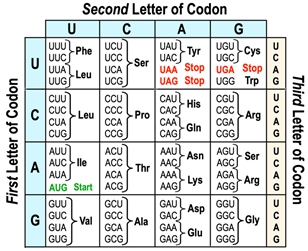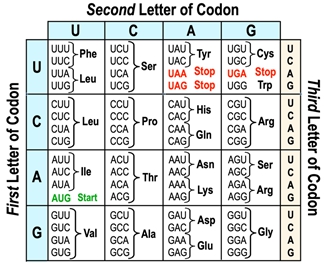In this video, we're going to talk about how to use the genetic code. And so notice down below over here on the right-hand side of our image, what we have is the genetic code. And so how exactly do you use this genetic code? Well, it turns out that using the genetic code is really just a 3-step process. And notice that we have each of those 3 steps numbered down below here.
And so the very first step of using the genetic code is actually to use the coding DNA sequence to reveal the mRNA sequence. And so really, this is the process of transcription using DNA to make mRNA. And so, of course, we know from our previous lesson videos that the mRNA sequence is going to be exactly the same as the coding DNA sequence, except for the fact that it's going to be replacing all of the t's or thymines with U's or uracils in the mRNA. And so if we take a look at our image down below over here on the left-hand side, notice that we're showing you a DNA molecule, which we know has 2 strands. One of the strands is going to be the DNA coding strand, which is going to be this top strand here, and the other strand is going to be the DNA template strand, which will be the bottom strand here.
And so, of course, we know from our previous lesson videos that the mRNA sequence is going to be exactly the same as the DNA coding strand which is the top strand. So the top strand is the one that we want to focus predominantly on. And so again, it's going to be exactly the same as this top strand except it's going to be replacing all of the t's or thymines with U's. And so as we start to reveal the mRNA sequence, we can see here we start off with a TG, and so we will put A, and it's tempting to put a T here as the mRNA, but we need to remember that in mRNA there are no T's and that the T's will be replaced with U's or uracils. And then of course we have the G.
So then we can continue to do that just by literally rewriting the coding sequence except replacing the t's with U's. And so when you do that, you get CAU, you get a CC here, you get UGU at these positions, and then you get UAA here. And so now we've revealed the mRNA sequence, and step 1 is complete. Now in step 2, what we need to do is identify the 3 nucleotide coding frames within the mRNA transcript. The mRNA molecule is sometimes referred to as the mRNA transcript.
And so identifying the 3 nucleotide coding frames includes identifying the start codon, which is typically where the first codon of the mRNA and also identifying the stop codon as well, which is typically going to be the last codon. And so, if we take a look at our image down below, we can kinda see step 2 has already been done for us because these dotted vertical lines that you see at these positions are kind of separating our mRNA into these three nucleotide codons. And so you can see here that we have the first codon would be AUG, then we have the second codon would be CAU, and then we have ACC and UGU, and then last but not least, UAA. So those are the codons, and notice that they've already been identified because we have separated them with these dotted lines. So step 2 is complete.
And so in step 3, all we need to do is identify the amino acid that corresponds with each of the codons until a stop codon is reached. And so the stop codon is going to stop the process because it does not actually code for an amino acid, and that's why the process stops at these stop codons. And so, of course, in order to identify the amino acids that each codon corresponds to, we need to use the genetic code over here. And so the genetic code is going to show the very first letter of the codon on the left-hand side of the table. So you can see the first letter of the codon here is going to be here.
And the first letter of the codon will limit us to a specific row. Then, of course, the second letter of the codon is going to be across the top. And so across the top here, we will find the second letter of the codon, and the second letter of the codon is going to limit us to a specific column. And so between the first and second letters, it will limit us to a specific box where they overlap. And so, at this point, we would be looking at just one specific box here.
Here. And then the third letter of the codon is going to be over on the right-hand side. So you can see the third letter is over here, and that would limit us to a specific position within the box so that it would reveal a specific codon. And so the genetic code shows all of the possible codons and linking these codons to amino acids. And so here in our example, what we're going to do is determine the polypeptide sequence or the protein sequence down below here, from the following DNA sequence.
And so we already have, used the DNA to reveal the mRNA sequence, so now we need to use the mRNA codons to reveal the amino acids in the polypeptide. And so we'll do this one codon at a time starting with the very first codon here, AUG. And so the very first letter of this codon is A. So the first letter of the codon is over on the left-hand side and A is going to limit us to a specific row. Then the second letter of this codon is U, and U is going to be, the second letter of the codon is across the top, and U is going to limit us to a specific column.
And so, where these two overlap would be right here in the middle, and so where this yellow region is. So we can kinda get rid of this to see it easier. So now we're focused on this particular box that's highlighted in yellow. Then we look at the 3rd and final code letter of codon, which is G. And the 3rd letter of the codon is going to limit us to a specific position within the box, and that takes us right here.
Since we have the G, you can kinda trace it all the way over and see that it's right here, AUG. And so AUG is, the codon is found right here. And it turns out that AUG is typically the start codon. It's the very first codon of most proteins. And so, it actually codes for an amino acid called methionine, which is abbreviated with the letters MET.
And so this first codon here, the start codon, is going to be MET. And notice that this polypeptide sequence, this amino acid sequence, is going to be revealed from the terminal of the protein to the C-terminal of the protein. And so methionine is the very first one. So now we just need to repeat this process for all of the other codons. So we'll do this again and, relatively slow here with CAU.
The very first letter of the codon is C. So the first letter of the codon is going to limit us to a specific row. Then the second letter of the codon is A, and the second letter codon is across the top, and A is right here. It limits us to a specific column. So now we're looking for where these two boxes overlap, which is gonna be right here in this yellow highlighted region.
So we can remove these and see this is the box that we're focusing on. And then the third letter of the codon is U here. And so U, the 3rd letter of the codon, is going to limit us to a specific position, CAU. And so what you can see here is that CAU, is the codon that codes for the amino acid histidine, which is abbreviated as HIS. And so, here for CAU, we can put in HIS.
And so again, we have revealed the first two, amino acids for the first two codons, and we just need to repeat the process again. So then we have ACC, and A is here, C is here, so now we're in this box. And then, C, the third letter of the codon, is here. So you see, ACC is right here, and that codes for a threonine amino acid. So that's THR abbreviation.
Then we have UGU. The first letter of the codon is U. The second_letter of the codon is G. And, the so that means that we're in this box. And the 3rd letter of the codon is U.
So UGU is right here. That codes for a cysteine amino acid, CYS. So put that here. And then last but not least, what we have is the last codon here, and the last codon is going to be a stop codon that does not code for an amino acid. And so when you use UAA in this, what you'll see is U is here, A is_here, so we're in this box.
And then the last letter of the codon is A, so that's here. And so UAA is right here at this position, and that is a stop codon. And what you'll notice is that there_are also 3 other stop codons, 3 in total. And, each of these_codons does not code for an amino acid. Instead, they don't code for an amino acid, and they help to trigger the the end of this process.
And so, UAA here is just going to be a stop codon. There's no amino acid_at this position. And so the polypeptide sequence is just going to be shortened. It's gonna be right here is the polypeptide sequence. It is methionine, histidine, threonine, and, cysteine.
And so now we have revealed exactly how to use this genetic code. And so we'll be able to get some practice applying these concepts as we move forward_through our course. So I'll see you all in our next video.





